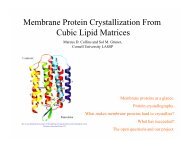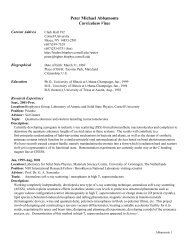Morphology and Gas Adsorption Properties of ... - ResearchGate
Morphology and Gas Adsorption Properties of ... - ResearchGate
Morphology and Gas Adsorption Properties of ... - ResearchGate
Create successful ePaper yourself
Turn your PDF publications into a flip-book with our unique Google optimized e-Paper software.
<strong>Morphology</strong> <strong>of</strong> Palladium-Cobalt-Based Cyanogels Chem. Mater., Vol. 15, No. 22, 2003 4241Figure 1. Carbon dioxide-argon recycling data for the 60 mMxerogel system illustrating the complete reversibility <strong>and</strong>reproducibility <strong>of</strong> CO 2 adsorption. Although the figure showsonly three CO 2-Ar cycles, this cycling was carried out 10 timeswith almost no change, indicating the reproducibility <strong>and</strong> thecomplete reversibility <strong>of</strong> CO 2 adsorption.The Pd-Co aerogels show a similar adsorption pr<strong>of</strong>ile;however, they take up about 9% by mass <strong>of</strong> CO 2 . Theadsorption <strong>of</strong> N 2 O by the gels is identical to that <strong>of</strong> CO 2in terms <strong>of</strong> the amount <strong>of</strong> the gas adsorbed. Theincreased gas adsorption by the aerogels is in line withtheir larger mean pore size 7 <strong>and</strong> exp<strong>and</strong>ed structure visà-visthe xerogels. Another indication <strong>of</strong> the smaller poredimensions <strong>of</strong> the xerogels is provided by the fact thatno detectable SF 6 adsorption is observed on the xerogels;the aerogels, in contrast, take up 11% <strong>of</strong> SF 6 by mass.Neither <strong>of</strong> the gels adsorbs Ar, N 2 ,O 2 ,orCH 4 underambient conditions: these gases, therefore, are suitablec<strong>and</strong>idates for desorbing the adsorbed gases <strong>of</strong>f the gels.Porosity <strong>of</strong> the Cyanogels. Microporosity <strong>of</strong> thePd-Co Xerogels. Figure 2 shows the N 2 <strong>and</strong> CO 2adsorption isotherms measured at -196 °C <strong>and</strong> 0 °C,respectively, for both the 0.4 M aero- <strong>and</strong> xerogels. Thexerogel isotherm is shown in Figure 2(a) <strong>and</strong> Figure 2(b)depicts that for the aerogel. The xerogel shows a distinctType I isotherm 15 indicating that it is almost purelymicroporous. The aerogel, on the other h<strong>and</strong>, yields aType IV isotherm, 15 characteristic <strong>of</strong> a mesoporous solid.The pore size distribution (PSD) in the cyanogels isshown in Figure 3. Figure 3(a) depicts the PSD plot forthe 0.4 M Pd-Co xerogel obtained by applying the SaitoFoley-extended Horvath Kawazoe (HK) model to thenitrogen adsorption data for the xerogel. As can beobserved, the pore diameters in the xerogel lie in thesub-2 nm range with a peak at 0.9 nm indicative <strong>of</strong> itsmicroporous nature.Figure 4(a) <strong>and</strong> (b) clearly illustrate the N 2 <strong>and</strong> theCO 2 adsorption isotherms, respectively, for both the 0.4M Pd-Co aerogel <strong>and</strong> xerogel in the low relativepressure regime. As can be seen, in this region the N 2<strong>and</strong> the CO 2 adsorption isotherms for both the gels arecurved. It has been shown 16 that curved isotherms inthe low relative pressure region are obtained frommaterials consisting <strong>of</strong> narrow microporessi.e., possessinga narrow microporosityswhereas wide microporosityleads to more linear isotherms in the low relativepressure region. Curved isotherms are associated with(16) Martin-Martinez, J. M.; Mittelmeijer-Hazeleger, M. C. Langmuir1993, 9, 3317.Figure 2. (a) Nitrogen adsorption isotherm at 77 K for the0.4MPd-Co xerogel. The classic Type I isotherm indicatesthat the xerogel is almost predominantly microporous. (b)Nitrogen adsorption <strong>and</strong> desorption isotherms obtained at 77K for the 0.4 M aerogel <strong>and</strong> xerogel. The volume adsorbed bythe aerogel is an order <strong>of</strong> magnitude greater than that for thexerogel.enhanced adsorption potential in micropores smallerthan two molecular diameters <strong>of</strong> CO 2 . 16 In such narrowpores, the potential fields from the neighboring wallsoverlap significantly, thereby enhancing the interactionpotential between the pore walls <strong>and</strong> the adsorbatemolecules. 17-19 This enhanced interaction leads to acurvature <strong>of</strong> the adsorption isotherm as a large amount<strong>of</strong> the adsorbate is adsorbed at very low relative pressures.The steep initial part <strong>of</strong> the xerogel isotherm,indicating that >75% <strong>of</strong> the pore volume is filled at p









